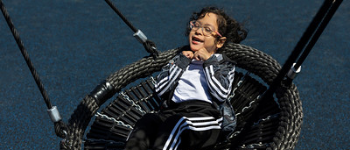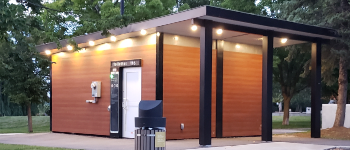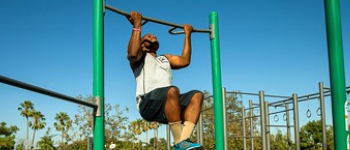How to Add Inclusive Play Design into an Existing Playground or Park
Aug 31







Jun 24
No matter their circumstances, everyone should feel empowered to get outside and have fun – especially children. Health experts say young children should be active throughout the day, and children and adolescents ages six through 17 should play at least 60 minutes daily.
That may sound like a lot, and it may seem very difficult when you factor in different levels of physical and social ability. How exactly do you build a playground that lets children play freely and creatively without excluding anyone? The Americans with Disabilities Act (ADA) helps ensure that every child, no matter their ability, can get out and enjoy playing on a playground. Using these guidelines, alongside inclusive playground design elements, you can rest easy knowing your playground is ADA compliant and a place for all children.
To ensure your current or next playground is ADA compliant and inclusive, we need to understand what the act entails and how it all connects to the concept of inclusivity. Let’s break it down!
The ADA, signed into law on July 26, 1990, prohibits the “discrimination against people with disabilities in several areas, including employment, transportation, public accommodations, communications and access to state and local government programs and services.” While parks and playgrounds fall under the category of “public accommodations,” playground designers and developers didn’t have much guidance for ensuring equal access to all people in such places until 2010. In 2010, the ADA released the Standards for Accessible Design, giving clear guidelines for playgrounds.
According to the ADA, to be accessible or inclusive, a playground must have the following:
At MRC, we take accessibility and inclusivity very seriously. Our team of experts can help determine how to best make your play area meet these standards through our surfacing, equipment, and other options. Let’s see how.
Aside from the standards we already mentioned, accessibility goes beyond surfacing and pathways. For example, once a child is within a play area, they must be able to access all equipment easily. This can be made possible by either moving out of their mobility device onto the structure via a transfer station or by direct access to their mobility device. You can ensure access to equipment by adding features such as a ramp leading to a piece of equipment. If you want to make sure you cover all your bases, take a quick look at our ADA playground checklist that features all the elements your playground needs for ADA compliance:
Compliance with the ADA is integral for your park or playground, but you can take it a step further. You can meet all the standards of the ADA and exceed the expectations of ADA regulations by creating a genuinely inclusive playground. Because every child is unique and inclusive playgrounds offer benefits that far outstretch simple ADA compliance, so we highly recommend them. So let’s dive into inclusive playgrounds.
Inclusive playgrounds are open and safe spaces carefully designed to promote play among children of differing abilities, ages, and communities. It gives children with and without any disability the same platform to play. They’re different from other outdoor areas because the goal is to eliminate all physical and social barriers so everyone - children, parents, caregivers, and community members - can experience the benefits of playing together. Benefits of inclusive play include:
How is this done? Inclusive play equipment, like the Inclusive Whirl, Sensory Wave Climber, and Rox-All-See-Saw, are designed to accommodate users of all abilities as they allow kids to quickly get on or transfer to and from a mobility device. Additionally, the various movements of these pieces of equipment engage kids’ senses and creativity. And, of course, they’re completely safe!
These are just a few examples of what makes an inclusive playground truly inclusive. We have an entire brochure of ADA-compliant and inclusive playground equipment that goes above and beyond the standard regulations to create an engaging play experience. Keep reading if you want additional details on different ADA and inclusive playground elements.
First and foremost, an inclusive playground should have accessible routes to the play structures. You may need to swap out sand or rocks for more accessible types of playground safety surfacing, such as poured-in-place rubber. There should also be no barriers to a child’s ability to play. For instance, a ramp allows kids to access higher parts of a play structure if they cannot walk up and down stairs. Remember that an inclusive playground does not simply place accessible equipment in a particular part of the park. Instead, accessibility should be infused throughout the design so that kids of all abilities can play together.
An inclusive playground design is influenced mainly by universal design, a product, environment, and building design framework. The seven principles of “universal design” are:
Examples of design essentials that adhere to these principles include ramp access, upper body events, graduated levels, cozy spots, adequate seating, and proper shade. Including universal design and its elements in an inclusive playground ensures that the space is accessible, safe, and comfortable and encourages social participation. In other words, it makes sure that everyone, no matter what, is included in your playground design!
If you’re starting from scratch with your play area or playground, what we’ve covered so far can help you navigate an ADA-compliant and inclusive playground. What if you want to make an established playground ADA compliant and more inclusive?
We know that some older playgrounds and outdoor spaces might not have all the ADA-compliant and inclusive design elements needed for a truly inclusive experience. The good news is that there are so many ways to embed inclusive design elements into an already-established park. Retrofitting, or repairing an existing playground, is a great way to modernize a structure and increase safety and accessibility, and it is cost-effective!
The first step to retrofitting your existing playground is to evaluate its current state. How old is your playground? Depending on your playground’s age, you may need to ensure the equipment is up to current standards. Scroll back up to our ADA playground checklist to see if you meet the regulatory requirements. If you’re concerned about anything in your playground, you can contact a local representative to replace any parts deemed unsafe.
After you’re confident in your playground’s safety, you can ask yourself: How much play value exists in your outdoor space? Ramps and transfer systems are necessary, but adding ground-level events and sensory panels is an extraordinary way to go beyond the essentials. Sensory panels and creative play events are a great way to meet everyone’s needs and create a rich, inclusive play design. Sensory play engages the five senses, regulating sensory systems in the body that help kids coordinate movement and behavior. Our Sensory Wave Climber is an example of an affordable and fun piece of ADA and inclusive equipment.
In addition to sensory panels, embedding ground-level or free-standing play events is an excellent decision that ensures plenty of accessible equipment for children of all ages and abilities. Embedding multiple free-standing events into your playground re-design allows children to have various play choices. Ground-level play events are significant for multigenerational play and accessibility.
Again, our options are affordable and meet all the standards you’re looking for. With our help, budget-minded playground planners have many opportunities to transform an outdated play area into one that is inclusive and completely ADA compliant. You can also find funding partners to help at any stage!
While adhering to the ADA is vital to creating and maintaining a playground meeting federal regulations, accessibility goes far beyond the law. A truly compliant and inclusive playground is a space for every child to come together and have fun with their friends and community, regardless of their physical or life circumstances.
Want to learn more? Check out our Ultimate Guide to Inclusive Playgrounds, where we explore everything you need to know about inclusivity regarding playgrounds, from definitions to ADA compliance and more.